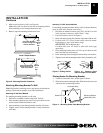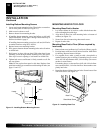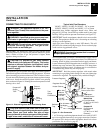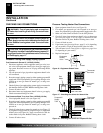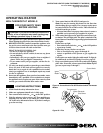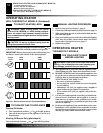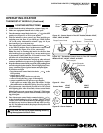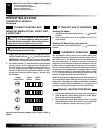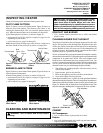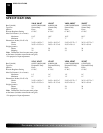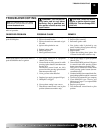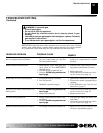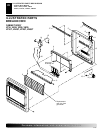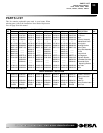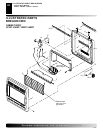
107887
For more information, visit www.desatech.com
For more information, visit www.desatech.com
17
17
GRH/OV 008BAD PILOT/LP
GRH/OV 007GOOD PILOT/LP
INSPECTING HEATER
Thermocouple
Pilot
Burner
Pilot
Burner
Thermocouple
Blue
Flame
Yellow Flame
CLEANING AND MAINTENANCE
ODS/PILOT AND BURNER
• Use a vacuum cleaner, pressurized air, or small, soft bristled
brush to clean.
CLEANING BURNER PILOT AIR INLET
The primary air inlet holes allow the proper amount of air to mix with
the gas. This provides a clean burning flame. Keep these holes clear
of dust, dirt, and lint. Clean these air inlet holes prior to each heating
season. Blocked air holes will create soot. We recommend that you
clean the unit every three months during operation and have heater
inspected yearly by a qualified service person.
We also recommend that you keep the burner tube and pilot assembly
clean and free of dust and dirt. To clean these parts we recommend using
compressed air no greater than 30 PSI. Your local computer store,
hardware store, or home center may carry compressed air in a can. You
can use a vacuum cleaner in the blow position. If using compressed air
in a can, please follow the directions on the can. If you don't follow
directions on the can, you could damage the pilot assembly.
1. Shut off the unit, including the pilot. Allow the unit to cool for
at least thirty minutes.
2. Inspect burner, pilot for dust and dirt.
3. Blow air through the ports/slots and holes in the burner.
4. Never insert objects into the pilot tube.
Clean the pilot assembly also. A yellow tip on the pilot flame indicates
dust and dirt in the pilot assembly. There is a small pilot air inlet about two
inches from where the pilot flame comes out of the pilot assembly (see
Figure 31). With the unit off, lightly blow air through the air inlet. You
may blow through a drinking straw if compressed air is not available.
WARNING: Turn off heater and let cool before
cleaning.
CAUTION: You must keep control areas, burner,
and circulating air passageways of heater clean. In-
spect these areas of heater before each use. Have
heater inspected yearly by a qualified service person.
Heater may need more frequent cleaning due to exces-
sive lint from carpeting, bedding material, pet hair, etc.
INSPECTING HEATER
Pilot Flame Pattern
Burner Flame Pattern
CLEANING AND MAINTENANCE
ODS/Pilot and Burner
Cleaning Burner Pilot Air Inlet
Cabinet
Check pilot flame pattern and burner flame pattern often.
PILOT FLAME PATTERN
Figure 27 shows a correct pilot flame pattern. Figure 28 shows an
incorrect pilot flame pattern. The incorrect pilot flame is not
touching the thermocouple. This will cause the thermocouple to
cool. When the thermocouple cools, the heater will shut down.
If pilot flame pattern is incorrect, as shown in Figure 28
• turn heater off (see To Turn Off Gas to Appliance, page 14 or 16,
depending on your model)
• see Troubleshooting, pages 19 through 21
Note:
The pilot flame on natural gas units will have a slight curve,
but flame should be blue and have no yellow or orange color.
Figure 27 - Correct Pilot Flame
Pattern
Figure 28 - Incorrect Pilot Flame
Pattern
BURNER FLAME PATTERN
Figure 29 shows a correct burner flame pattern. Figure 30 shows an
incorrect burner flame pattern.
If burner flame pattern is incorrect, as shown in Figure 30
• turn heater off (see To Turn Off Gas to Appliance, page 14 or 16,
depending on your model)
• see Troubleshooting, pages 19 through 21
Figure 29 - Correct Burner
Flame Pattern
Bad Burner Pattern-Plaque
GRH/OV 019
CABINET
Air Passageways
• Use a vacuum cleaner or pressurized air to clean.
Exterior
• Use a soft cloth dampened with a mild soap and water mixture.
Wipe the cabinet to remove dust.
Figure 30 - Incorrect Burner
Flame Pattern
Figure 31 - Pilot Inlet Air
Pilot Assembly
Pilot Air Inlet



